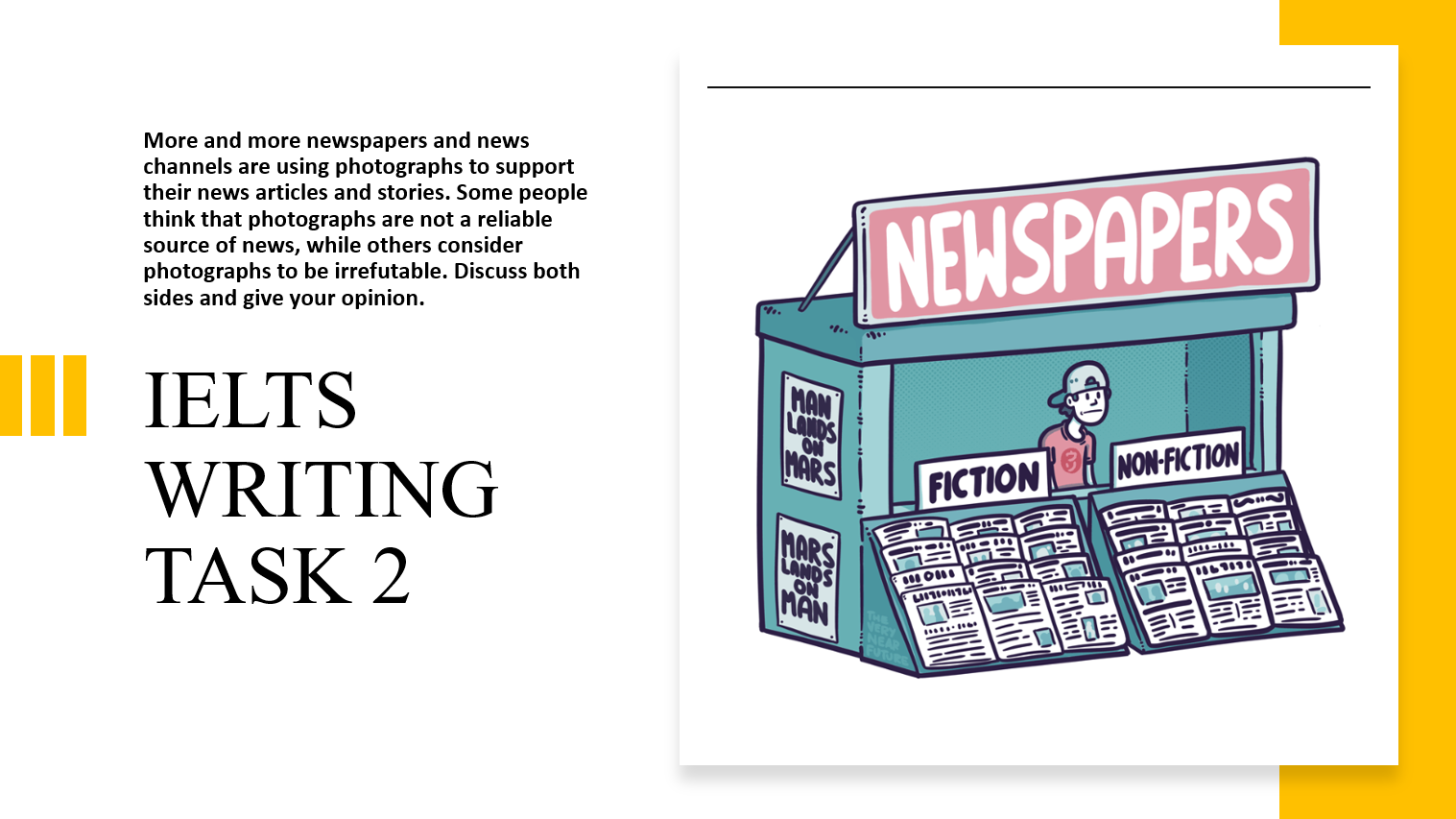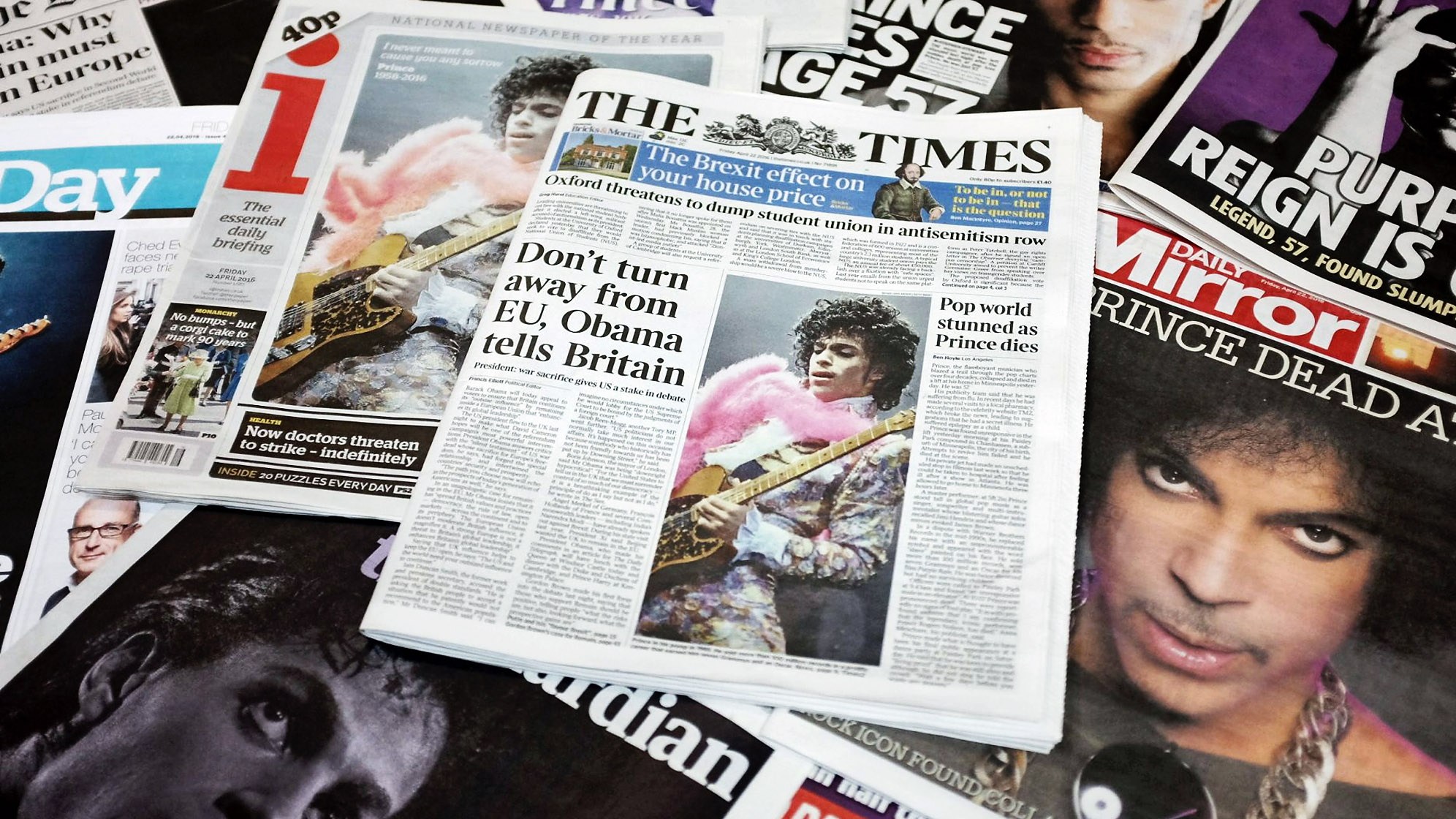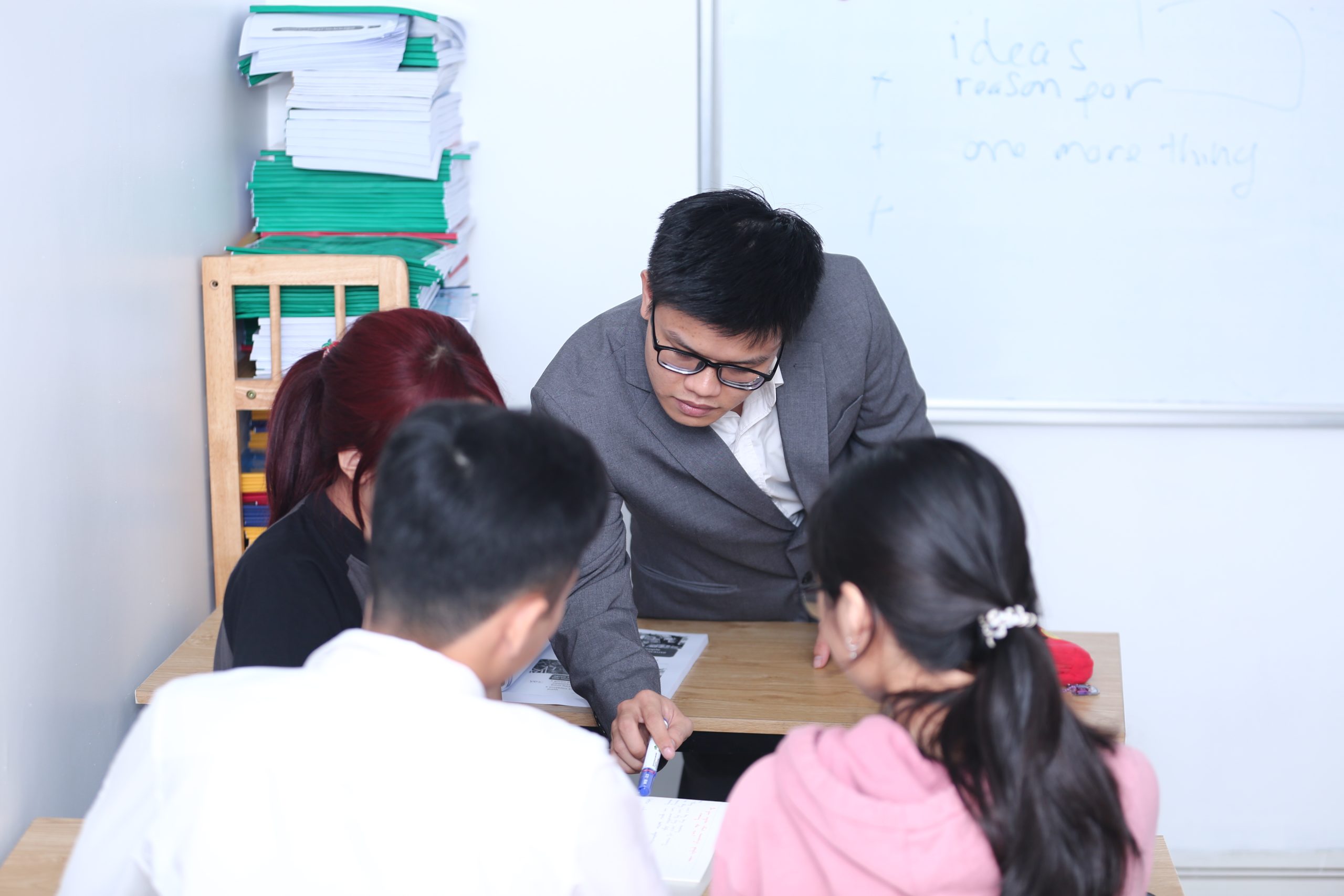Xin chào mọi người! Hôm nay, Hà English và các bạn sẽ cùng nhau thảo luận về một bài mẫu IELTS Writing Task 2 với chủ đề Truyền thông/Quảng cáo. Câu hỏi của chúng ta bao gồm hai phần: “More and more newspapers and news channels are using photographs to support their news articles and stories. Some people think that photographs are not a reliable source of news, while others consider photographs to be irrefutable. Discuss both sides and give your opinion.”
Sự phổ biến của hình ảnh trong truyền thông đang thu hút sự quan tâm về tính đáng tin cậy của chúng trong việc truyền đạt tin tức. Trong bài viết này, chúng ta sẽ thảo luận về cả hai quan điểm về sự tin cậy của hình ảnh trong truyền thông và đưa ra quan điểm cá nhân.

Mục lục
Đề bài:
More and more newspapers and news channels are using photographs to support their news articles and stories. Some people think that photographs are not a reliable source of news, while others consider photographs to be irrefutable. Discuss both sides and give your opinion.
Các bước làm bài IELTS Writing Task 2 dành cho đề bài trên
Step 1: Understand Our Task
Our task is to discuss the use of photographs in newspapers and news channels as a means to support news articles and stories. We need to evaluate the reliability of photographs as a source of news and consider both the arguments in favor of and against their credibility.
Bước 1: Hiểu nhiệm vụ của chúng ta
Nhiệm vụ của chúng ta là thảo luận về việc sử dụng hình ảnh trong báo và các kênh tin tức làm phương tiện hỗ trợ cho các bài viết và câu chuyện tin tức. Chúng ta cần đánh giá tính đáng tin cậy của hình ảnh như một nguồn tin tức và xem xét cả các lập luận ủng hộ và phản đối về tính đáng tin cậy của hình ảnh này.
Step 2: Decide Our Position
In this essay, I will argue that photographs can be both reliable and unreliable sources of news. The reliability of a photograph depends on various factors, and it is essential to approach them critically. While photographs can provide valuable visual evidence, they can also be manipulated or taken out of context.
Bước 2: Quyết định quan điểm của chúng ta
Trong bài viết này, tôi sẽ bào chữa rằng hình ảnh có thể là nguồn tin đáng tin cậy và không đáng tin cậy. Độ tin cậy của một bức hình ảnh phụ thuộc vào nhiều yếu tố và quan trọng là tiếp cận chúng một cách phản biện. Mặc dù hình ảnh có thể cung cấp bằng chứng thị giác có giá trị, nhưng chúng cũng có thể bị thao túng hoặc được lấy ra khỏi ngữ cảnh.
Step 3: Extend Our Answer
Arguments in Favor of Photographs as Reliable Sources of News:
- Visual Evidence: Photographs often capture events in real-time, providing a visual representation of a news story. They can be powerful tools for conveying the reality of a situation, making them highly reliable in conveying certain aspects of news.
- Emotional Impact: Photographs have the power to evoke emotions and create empathy among viewers. This emotional connection can make news stories more relatable and impactful.
- Documentation: In many cases, photographs serve as historical documentation, preserving crucial moments in time. They can be used as evidence in legal and historical contexts.
Arguments Against Photographs as Reliable Sources of News:
- Manipulation: Photographs can be manipulated through editing software, altering the truth. In the age of digital editing, it has become easier to doctor images, casting doubt on their reliability.
- Context Matters: A photograph captures a single moment in time and space. Without proper context, a photograph can be misleading or misinterpreted. The context surrounding the image is crucial for its accuracy.
- Subjectivity: Even unaltered photographs can be subjective. The angle, framing, and timing of a photograph can influence the viewer’s perception. This subjectivity can affect the reliability of the image as a source of news.
Bước 3: Mở rộng quan điểm của chúng ta
Lập luận ủng hộ hình ảnh là nguồn tin đáng tin cậy:
- Bằng chứng thị giác: hình ảnh thường ghi lại các sự kiện trong thời gian thực, cung cấp một biểu đồ thị giác về một câu chuyện tin tức. Chúng có thể là công cụ mạnh mẽ để truyền tải hiện thực của một tình huống, làm cho chúng đáng tin cậy trong việc truyền đạt một số khía cạnh của tin tức.
- Tác động tinh thần: hình ảnh có sức mạnh kích thích cảm xúc và tạo ra sự đồng cảm giữa người xem. Mối kết nối tinh thần này có thể làm cho câu chuyện tin tức trở nên gần gũi và có tác động mạnh mẽ hơn.
- Tài liệu: trong nhiều trường hợp, hình ảnh được sử dụng như một bằng chứng lịch sử, bảo tồn các khoảnh khắc quan trọng trong thời gian. Chúng có thể được sử dụng như bằng chứng trong ngữ cảnh pháp lý và lịch sử.
Lập luận phản đối về hình ảnh là nguồn tin đáng tin cậy:
- Thao tác: Hình ảnh có thể bị thao túng thông qua phần mềm chỉnh sửa, làm biến đổi sự thật. Trong thời đại chỉnh sửa số, việc chỉnh sửa hình ảnh đã trở nên dễ dàng hơn, gây nghi ngờ về tính đáng tin cậy của chúng.
- Ngữ cảnh quan trọng: một bức hình ảnh ghi lại một khoảnh khắc duy nhất trong thời gian và không gian. Thiếu ngữ cảnh thích hợp, một bức hình ảnh có thể gây hiểu nhầm hoặc được giải thích sai. Ngữ cảnh xung quanh hình ảnh là quan trọng để đảm bảo tính chính xác của nó.
- Tính chủ quan: ngay cả những bức hình ảnh chưa được chỉnh sửa cũng có thể mang tính chủ quan. Góc chụp, khung cảnh và thời điểm của một bức hình ảnh có thể ảnh hưởng đến cách người xem nhận thức. Tính chủ quan này có thể ảnh hưởng đến tính đáng tin cậy của hình ảnh như một nguồn tin tức.

Full Sample Essay
Introduction
Photographs have become an integral part of news reporting, adding a visual dimension to stories. The use of photographs in newspapers and news channels has raised questions about their reliability as sources of news. In this essay, we will explore both sides of the argument regarding the reliability of photographs in news reporting. While photographs can offer valuable visual evidence and emotional impact, we must also consider the potential for manipulation and the importance of context in interpreting them.
Body Paragraph 1: Arguments in Favor of Photographs as Reliable Sources of News
Photographs hold the potential to be highly reliable sources of news. They serve as visual evidence, capturing events as they unfold. For instance, a photograph of a natural disaster or a protest can provide viewers with a direct and unfiltered glimpse of the situation. The emotional impact of such images is undeniable; they have the power to evoke empathy and connect audiences to the stories being told. Moreover, photographs often serve as historical documentation, preserving significant moments for future generations. In these ways, photographs can be considered irrefutable sources of news that offer a unique and valuable perspective.
Body Paragraph 2: Arguments Against Photographs as Reliable Sources of News
However, the reliability of photographs is not without its challenges. In an era of advanced digital editing, the manipulation of images has become more prevalent. Photographs can be doctored to convey false information or mislead the public. Additionally, the context surrounding a photograph is crucial for its interpretation. A single image can capture just one moment in time and space, and without context, it may be misunderstood or taken out of context. Furthermore, photographs, even when unaltered, are inherently subjective. Factors like angle, framing, and timing can influence the viewer’s perception, making them potentially unreliable sources of news.
Conclusion
In conclusion, the use of photographs in news reporting is a double-edged sword. While they can offer powerful visual evidence and evoke emotions, they are not always reliable sources of news. Their reliability depends on various factors, including the potential for manipulation, the context in which they are presented, and their inherent subjectivity. It is crucial for both news consumers and journalists to approach photographs critically and consider the broader context when interpreting them. Ultimately, photographs can be a valuable addition to news reporting, but they should not be considered irrefutable sources of truth.
Useful Phrases/Collocations (with Vietnamese meanings):
- Visual evidence: Bằng chứng hình ảnh
- Emotional impact: Tác động cảm xúc
- Historical documentation: Tư liệu lịch sử
- Manipulation: Sự can thiệp, chỉnh sửa
- Context matters: Ngữ cảnh quan trọng
- Subjectivity: Tính chủ quan
- Interpretation: Sự diễn giải
- Mislead the public: Đánh lừa công chúng
- Inherent subjectivity: Tính chủ quan vốn có
- Approach critically: Tiếp cận một cách phê phán
Xem thêm các bài viết IELTS Writing Task 2 khác TẠI ĐÂY
Tổng kết
Qua bài viết này, chúng ta đã thảo luận về vai trò của hình ảnh trong truyền thông và tính đáng tin cậy của chúng trong việc truyền đạt tin tức. Câu hỏi này đặt ra một vấn đề quan trọng về sự tin cậy của thông tin hình ảnh và sự khả năng bác bỏ của nó.
Mặc dù hình ảnh có thể là một phần quan trọng trong việc minh họa tin tức, nhưng cần xem xét cả hai khía cạnh của sự đáng tin cậy và khả năng chinh phục của hình ảnh. Điều này phụ thuộc vào khả năng xác minh và nguồn gốc của hình ảnh cũng như sự cân nhắc của mỗi người đối với thông tin mà họ tiếp thu. Hà English hy vọng rằng bài viết này đã giúp bạn hiểu rõ hơn về chủ đề này và cách xem xét tính đáng tin cậy của hình ảnh trong truyền thông.
Nếu bạn đang tìm kiếm một trung tâm Anh ngữ uy tín và chất lượng, Hà English là một sự lựa chọn tuyệt vời. Với hơn 10 năm kinh nghiệm trong lĩnh vực giảng dạy tiếng Anh, trung tâm đã đạt được uy tín cao trong việc đào tạo học viên về ngoại ngữ.

Hà English tự hào là một môi trường học tập chuyên nghiệp và thân thiện, với đội ngũ giáo viên có trình độ cao và giàu kinh nghiệm. Những giảng viên tại trung tâm không chỉ sở hữu kiến thức chuyên môn vững vàng mà còn có khả năng tạo động lực và sự hứng thú trong quá trình học tập của học viên.
Dạy từ tâm – nâng tầm tri thức
Đăng kí tư vấn nhận lộ trình học phù hợp từ Hà English ngay!
